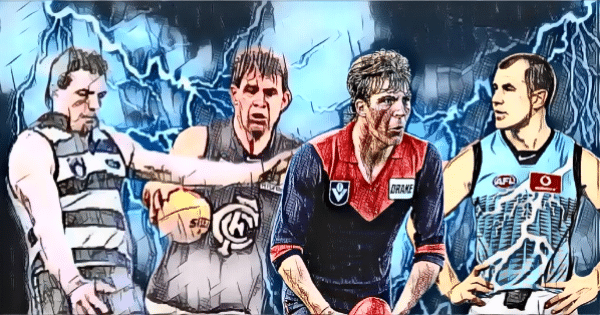Some players stand out in our memories and many of us, myself included, have lionised them over the years, making them seem grander than perhaps they really were.
The AFL Hall of Fame is littered with players who excelled at the highest level and achieved enormous feats of brilliance on the field, but not all players we’ll cover here will have been announced as part of the game’s elite.
Here at The Mongrel Punt, I have always endeavoured to look a little beyond the obvious, flitter between household names and some that maybe… just maybe have slipped your mind over the years.
In this series profiling the heroes of the game, we look at some of the players who were vital to their teams’ success in different capacities.
And believe me – there are plenty of them. And we ask – just how good were they?
You can find the previous five instalments of this series HERE.
PAUL ROOS
I have been on a bit of a vintage football binge recently, and several of the games have involved Fitzroy. Good, hard footy, and close contests in those games, and one man just seemed ahead of his time.
That man was Paul Roos, and watching him was like seeing a player from the modern game slotting into a 1980s game.
Roos’ ability to read the footy in flight, zone off and intercept, was the best in every game I watched. He wust a natural footballer, who, with the benefit of hindsight, was an obvious coach-in-waiting.
Playing across half-back, Roos was one of the reasons that the Roys were playing finals in the eighties. His pairing with Gary Pert is one of the more underrated one-two punches I’ve seen, albeit in a smaller sample size.
I’m not saying he revolutionised the sport, or how defence is played, but as you watch him go to work in home and away games, finals, and state games, you can see modern defensive tactics playing out long before they became common.
RUSSELL GREENE
When you look at the list of ALFPA Leigh Matthews Medal winners, the name of Russell Greene is probably one that stands out as a less glamorous recipient, at least to those who haven’t seen him in action.
Greene was a star for the Saints from the mid-seventies through to 1980, but it was after his move to Hawthorn that he played his best footy.
Greene’s MVP year was 1984, when he averaged 26 disposals per game, as Lethal Leigh Matthews started to slow down and play more of a forward role. His move from the Saints resulted in playing in three flags with the Hawks, and he made the VFL team of the year twice (equivalent to All Australian selection) in 83 and 84.
In the most recent game I viewed (1984 QF versus Carlton), Greene was everywhere. To me, he looked like the fittest bloke on the park, and continued to run hard long after others had tired. He topped the disposal count with 34 – eight more than the next highest on the park (Rod Ashman).
Of all the MVP winners, I reckon he is the most underrated.
JIM STYNES
It’s amazing to watch Jim Stynes play footy with the benefit of hindsight. We’ve been blessed by Irishmen who have come across and adopted our sport, as they have played it with as much passion as locals.
None moreso than Stynes.
Whilst his first year in the system wrought heartbreak, and a mistake that played a big part in costing his team a Grand Final berth, Stynes’ career only got better from that point on.
Did you know he never averaged more than 15 hit outs per game? I discovered this when I was researching big blokes who’d recorded games of 20+ disposals and 20+ hit outs. I was amazed at just how Stynes took the ruck role, and through hard work, just changed the way it was viewed.
Within a five year span, he went from the big Irish bloke who ran across the mark and gave Gary Buckenara an easier shot at goal, to averaging over 22 disposals per game for three straight years, with a Brownlow coming in the first of those seasons.
Whilst rucks’ second efforts are common now, back then, Stynes rolled up his sleeves and went to work each week. He may have been beaten in ruck contests, but in terms of following up, there were few better. We’ve heard the phrase “it’s like having an extra midfielder” in relation to mobile rucks, but with Stynes, it was incredibly accurate.
WARREN TREDREA
I thought I’d throw him into the mix, given the recent controversy involving the cessation of his duties as a Port Adelaide director.
It’s a shame that some will remember him for that, rather than the dominant centre half forward powerhouse he was. From 1999 through to the late 2000s, Tredrea was a contested marking beast, and the focal point of the Power’s forward line. He won their goal kicking eight times, and secured four All-Australian blazers, whilst taking the best defender every single week.
Whilst Collingwood can lay claim to being the Brisbane Lions’ greatest nemeses at the time, my memory is of Port Adelaide looking every bit like the heir apparent to the premiership throne. They were so close through 2001-03, before finally overcoming the Lions in 2004.
Two games I watched recently saw Tredrea dominate. In 2002, his 14 marks and five goals dismantled the Eagles, and the following season, his 23 touches, ten marks, and seven goals did the same to the Bombers.
He was a powerful specimen and bled black, white, and teal, at the time. An all-time great, irrespective of your opinion about him now.
MARK BAIRSTOW
I can remember sitting with my Dad and watching the 1989 Brownlow Medal count – yep, exciting times back in the Meyers household back then. When Paul Couch won the medal, my Dad said he should get another one made and hand it over to Mark Bairstow.
Funny, he said the same thing about Gerard Healy winning the Brownlow for the Swans, as he thought Diesel Williams was doing the hard yards.
Couch was silky, but Bairstow built his game on power running. He hit the contest hard and had a stellar run in the V/AFL in his seven years. So, just seven years?
Starting at 23 years of age, Bairstow already had a couple of seasons at South Fremantle under his belt, but after the Cats lost the Grand Final in 1994, Malcolm Blight moved on as coach, and Gary Ayres stepped in.
And that was it for Bairstow. He had surgery to repair what was reported as bone spurs, which was deemed a success, but in a huge shock, Ayres delisted him. Just like that… gone.
He played a belter in the Round 22 game of 1987, as the Hawks managed to hold on by three points, despite Bairstow picking up 32 touches, and his Round 12 1991 game against the Hawks is one of the best you’ll see, as he tallies 36 disposals and six goals in an incredible showing.
Seriously, if you want to see a midfielder at his destructive best, Bairstow obliterated the Hawks – the eventual premiers – in a masterful performance. Look it up (Dermott kicks eight for the Hawks!). It should be subtitled ‘The Bairstow Game’. He owned it.
Keep an eye out in the coming weeks for a standalone “Time Machine” review of that game, by the way.
BRETT RATTEN
Newer fans will be tempted to remember Ratten as a failed coach at Carlton and St Kilda, and despite extenuating circumstances in both cases, they’d be right. That said, to discount how good he was in the heat of battle is an incredible disservice to the man.
Here is a little stat that you can hang your hat on right now; nobody has ever had more clearances in a Grand Final than Brett Ratten.
In the 1999 decider, despite his Blues being outclassed, the on-baller racked up a mammoth 16 clearances. In the entire history of AFL finals – not just Grand Finals – only one man has matched that number. It was Josh P Kennedy of the Swans in 2011.
Imagine the Blues had won that decider? Imagine the esteem his performance would be held in?
His 1999 finals series saw him return averages of 26.75 disposals and 12.25 clearances. If only the Gary Ayres Medal was around back then, huh?
You can pick any game from that 1999 season, and chances are, Ratten is picking up the first touch at stoppages more than anyone else. He had 10+ clearances in 15 games that season, to end up averaging 10.19 per game for the year.
Patrick Cripps is the next highest clearance winner, with 8.81 in 2016.
Ratten’s 1999 remains the highest single-season clearance average the game has seen. Give the man the credit he deserves – he was a star.
Like this content? You could buy me a coffee – I do like coffee, but there is no guarantee I won’t use it to buy a doughnut… I like them more. And I am not brought to you by Sportsbet or Ladbrokes… or Bet365, or any of them.



